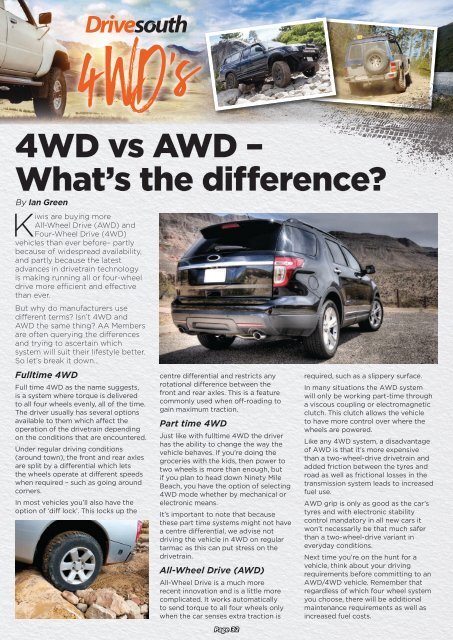You also want an ePaper? Increase the reach of your titles
YUMPU automatically turns print PDFs into web optimized ePapers that Google loves.
4WD vs AWD –<br />
What’s the difference?<br />
By Ian Green<br />
Kiwis are buying more<br />
All-Wheel Drive (AWD) and<br />
Four-Wheel Drive (4WD)<br />
vehicles than ever before– partly<br />
because of widespread availability,<br />
and partly because the latest<br />
advances in drivetrain technology<br />
is making running all or four-wheel<br />
drive more efficient and effective<br />
than ever.<br />
But why do manufacturers use<br />
different terms? Isn’t 4WD and<br />
AWD the same thing? AA Members<br />
are often querying the differences<br />
and trying to ascertain which<br />
system will suit their lifestyle better.<br />
So let’s break it down…<br />
Fulltime 4WD<br />
Full time 4WD as the name suggests,<br />
is a system where torque is delivered<br />
to all four wheels evenly, all of the time.<br />
The driver usually has several options<br />
available to them which affect the<br />
operation of the drivetrain depending<br />
on the conditions that are encountered.<br />
Under regular driving conditions<br />
(around town), the front and rear axles<br />
are split by a differential which lets<br />
the wheels operate at different speeds<br />
when required – such as going around<br />
corners.<br />
In most vehicles you’ll also have the<br />
option of ‘diff lock’. This locks up the<br />
centre differential and restricts any<br />
rotational difference between the<br />
front and rear axles. This is a feature<br />
commonly used when off-roading to<br />
gain maximum traction.<br />
Part time 4WD<br />
Just like with fulltime 4WD the driver<br />
has the ability to change the way the<br />
vehicle behaves. If you’re doing the<br />
groceries with the kids, then power to<br />
two wheels is more than enough, but<br />
if you plan to head down Ninety Mile<br />
Beach, you have the option of selecting<br />
4WD mode whether by mechanical or<br />
electronic means.<br />
It’s important to note that because<br />
these part time systems might not have<br />
a centre differential, we advise not<br />
driving the vehicle in 4WD on regular<br />
tarmac as this can put stress on the<br />
drivetrain.<br />
All-Wheel Drive (AWD)<br />
All-Wheel Drive is a much more<br />
recent innovation and is a little more<br />
complicated. It works automatically<br />
to send torque to all four wheels only<br />
when the car senses extra traction is<br />
Page 32<br />
required, such as a slippery surface.<br />
In many situations the AWD system<br />
will only be working part-time through<br />
a viscous coupling or electromagnetic<br />
clutch. This clutch allows the vehicle<br />
to have more control over where the<br />
wheels are powered.<br />
Like any 4WD system, a disadvantage<br />
of AWD is that it’s more expensive<br />
than a two-wheel-drive drivetrain and<br />
added friction between the tyres and<br />
road as well as frictional losses in the<br />
transmission system leads to increased<br />
fuel use.<br />
AWD grip is only as good as the car’s<br />
tyres and with electronic stability<br />
control mandatory in all new cars it<br />
won’t necessarily be that much safer<br />
than a two-wheel-drive variant in<br />
everyday conditions.<br />
Next time you’re on the hunt for a<br />
vehicle, think about your driving<br />
requirements before committing to an<br />
AWD/4WD vehicle. Remember that<br />
regardless of which four wheel system<br />
you choose, there will be additional<br />
maintenance requirements as well as<br />
increased fuel costs.


















